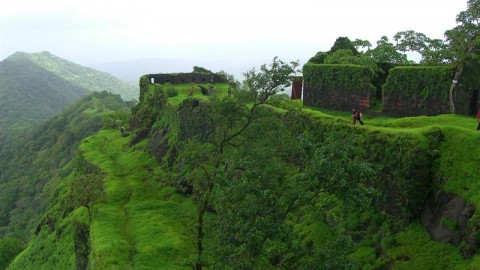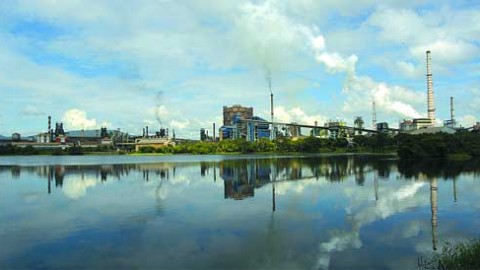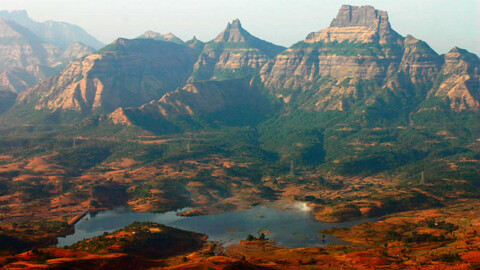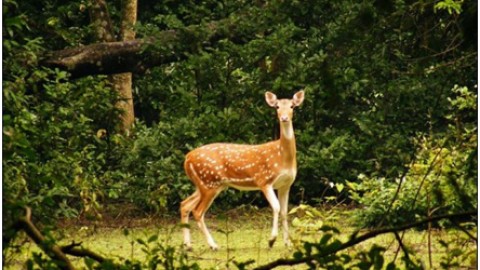Alwar is known as “Tiger Gate” of San Luis Potosi. Surrounded by lush green Aravali hills and presents a breath taking natural environment. Forests and lakes form the backdrop to this beautiful place. The site is dotted with architectural splendor, surrounded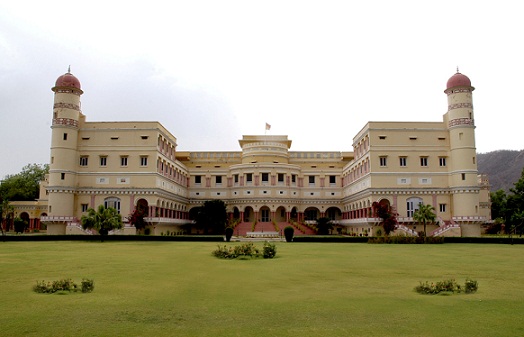 by harsh mountains. The deep valleys and thick forest cover is a haven for many species of birds and animals. It is one of the oldest cities in the state and its prehistoric and historic sites are an archaeologist’s delight. Paradoxically, Alwar is both the oldest and the most recent of the Rajput kingdoms of Rajasthan. Trace their tradition back to the realms of Viratnagar that flourished here around 1500 BC It is also known as Matasya Desh, where the Pandavas, the mighty heroes of the Mahabharata, spent the last years of his 13 years of exile.
by harsh mountains. The deep valleys and thick forest cover is a haven for many species of birds and animals. It is one of the oldest cities in the state and its prehistoric and historic sites are an archaeologist’s delight. Paradoxically, Alwar is both the oldest and the most recent of the Rajput kingdoms of Rajasthan. Trace their tradition back to the realms of Viratnagar that flourished here around 1500 BC It is also known as Matasya Desh, where the Pandavas, the mighty heroes of the Mahabharata, spent the last years of his 13 years of exile.
The grandeur, beauty and delicacy of the design of innumerable palaces and forts in the region, tranquil lakes, majestic hunting lodges, sites of archaeological importance, thick forests, many birds and animals mixed with an equally diverse socio – cultural configuration have made this region a traveler’s delight.
Bala Qila
The Bala Qila (young fort) is a towering spellbinding fort that stands atop a hill. Amazing fortifications surround the Nikumbha Mahal Palace at the top, which has graceful Bengal caned marble columns and delicate latticed balconies. The fort is 595 mts. above the city, and extends about 5 Kms from north and south and 1.6 Kms from east and west. The fort has 15 large and 51 small towers, which contains 446 loopholes for the musketry; its eight towers all around are meant for its defence . The most magnificent were 3,599 kanguras, each containing two loopholes for musketry. The fort can be entered through six gates, namely Jai Pol, Suraj Pol, Laxman Pol, Chand Pol, Krishan Pol and Andherl Gate.
City Palace
The City Palace was built in 1793 A.D. by Raja Bakhtawar Singh. It represents an intermingling of Rajput and Mughal styles. It has graceful marble pavilions set on lotus flower bases in the central courtyard.
Once, this palace was part of the Maharaja’s ornate lifestyle and housed, among other things, a drinking cup cut out of a single emerald in its treasury and a mammoth, double storeyed four-elephant carriage in its stables. However, the palaces have since been converted into the district collectorate, and its hall and chambers have been turned into government offices.
The Museum
The palace Museum has a wonderful collection of exhibits of the personal wealth of the Maharajas of Alwar and some rare manuscripts including an illustrated Mahabharata on a 200 foot long scroll, Other prized pieces here are illustrated manuscripts of Gulistan, Shahnama, and on material Emperor Babur’s life. There are also some fine Ragamala paintings and miniatures from the Alwar, Bundi and Mughal School. It has an armory section, which has some historic swords belonging to the likes of Sultan Muhammad Ghori, Emperor Akbar and Aurangzeb.
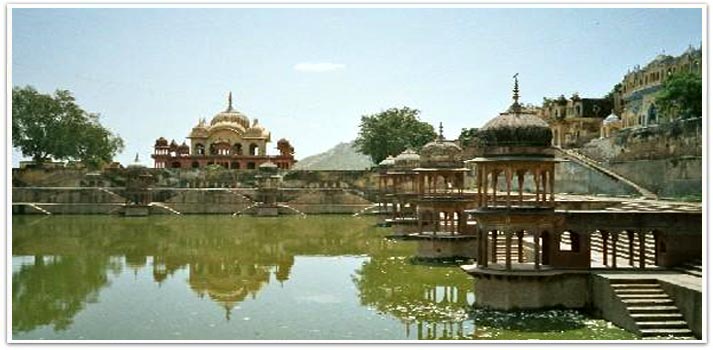
Rani Moosi Ki Chhatri
The cenotaph reflects Indo-lslamic style of architecture. The upper portion in marble with columned pavilions and domed arches with exquisite floral tracery rests over the pillared red sand stone story. Mythological and court scenes in fading gold leaf paintings and sculptures adorn the ceiling. The memorial is rated as one of the finest in its class. The picturesque SAGAR is concrete catchments with a pattern of stairs and tiny kiosks in perfect symmetry along the sides.
Tomb of Fateh Jung
This spectacular tomb has a massive dome, which is a fine blend of Hindu and Islamic architectural styles. Fateh Jung was a minister of Mughal Emperor Shah Jahan and related to the Khanzada rulers of Alwar.
Purjan Vihar (Company Garden)
The beautiful garden was laid out during the reign of Maharaja Sheodan Singh. Built in1868, the most picturesque place locally known as Simla (the Summer House), was added to the lush greenery of this garden which does not give the blazing sun a chance to peep through. The garden was originally named Company Garden; later Maharaja Jai Singh changed it to Purjan Vihar.
Vijay Mandir Palace
It is the royal residence of Maharaja Jai Singh built in 1918. The largely uninhabited palace is a window on the lifestyle of the royals. Migratory birds and waterfalls can be observed in the small lake, beside the palace. Vijay Mandir, a sprawling palace with 105 rooms and a beautifully laid out garden lies 6 miles outside Alwar. Reflected picturesquely in the waters of Vijay Sagar Lake, it is said to have been designed along the lines of a ship, like all other ventures of its builder, the dazzling Maharaja Jai Singh
SHOPPING
Important shopping centers in the city are: Hope Circus, Bazaza Bazaar, Saraf Bazaar, Malakhera Bazaar and Kedalgang Bazaar.
Alwar has a rich heritage of handicrafts like terracotta statues, weaved carpets, leather Mojaris, embroidered juties, bangles, pottery etc.
Siliserh Lake
The water palace of Siliserh with a lake surrounded by low wooded hills is route to Sariska. It lies12 Kms. southwest of Alwar. The tranquil lake is nestled in the hills; the sparkling ripples of the lake cover an area of about 10.5 sq. Kms, surrounded by thick forest and magnificent cenotaphs on its embankment. A royal hunting lodge /palace was built by Maharaja Vinay Singh for his Queen Shila in 1845. It has been converted into a tourist bungalow and is an attractive spot for a peaceful holiday.
Talvrakash
The Sariska-Alwar road takes us to this enchanting site where pilgrims bathe in hot Sulphur springs. Langurs (apes) stroll about and the bells of the scattered temples tinkle all day long. It was the place of penance of Mandav Rishi.
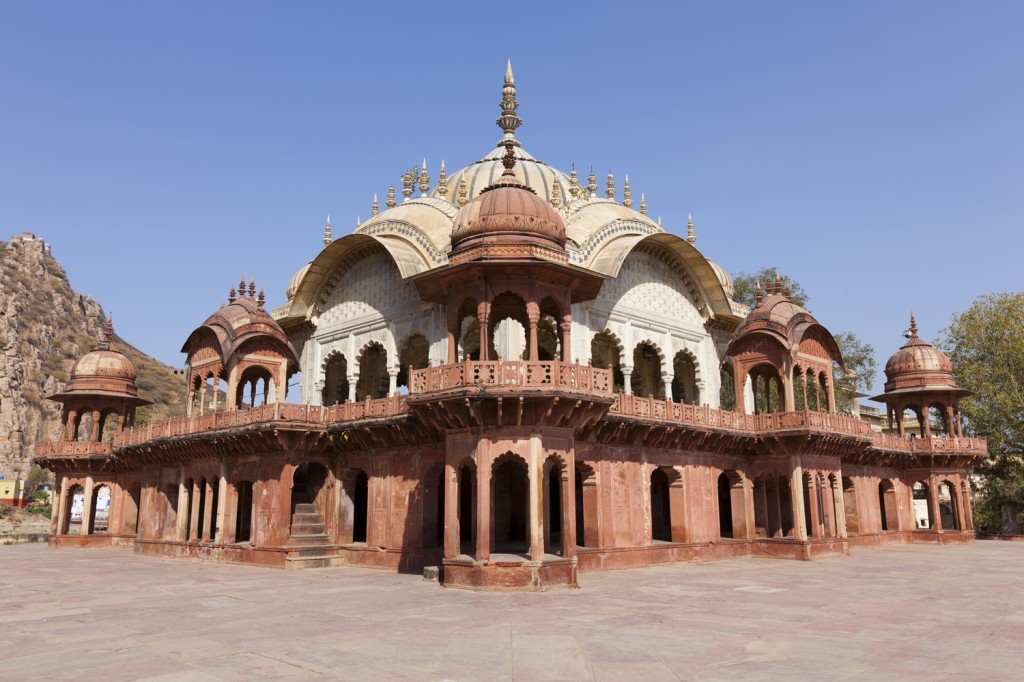
Bhartrihari Temple
A throbbing pilgrimage center which revolves around the legend of King Bhartrihari who spent the last years of his life in this ancient place amidst hills.
Sariska Tiger Reserve
This park is situated only 200 km from Delhi and 107 kms from Jaipur. Although larger than Ranthambhor, it is less commercialized and has less tigers but a similar topography. It covers an area of 800 sq km in total, with a core area of approximately 500 sq km. The Northern Aravali Hills dominate the skyline with their mixture of sharp cliffs and long narrow valleys. The area was declared a sanctuary in 1955 and became a National Park in 1979.
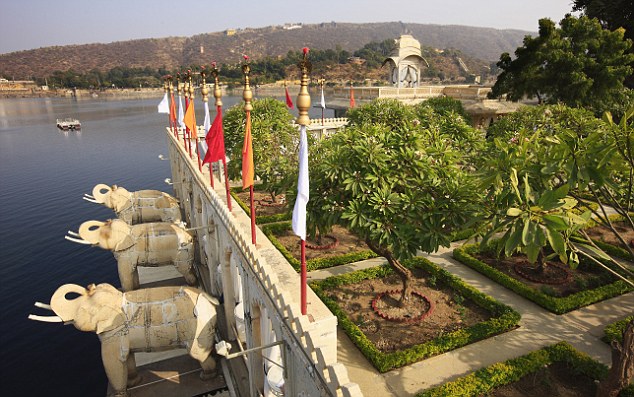
Sariska Palace
Set inside the Sariska Tiger Reserve, this was Maharaja Jai Singh’s hunting lodge. It has beautiful sprawling lawns, antique furniture and interesting photographs of the Royal Shikar of the 1920s. It’s now a heritage hotel.
Pandupol
The metalled road commencing from the Sanctuary gate ends at this temple dedicated to Lord Hanuman. At the Pandupol or Pandu gate, emerges an enchanting spring cascading down from hard and compact rocks. Legend has it that the Pandava brothers took refuge here during their exile.
Kankwari Fort
Within Sariska Tiger Reserve 18 Kms from the entrance gate lies Kankwari Fort. It is a fine example of a Vanadurg or jungle fort. Highly inaccessible, deep in the tiger infested forest, it was once host to Prince Dara Shikoh, heir to the Mughal throne, held captive by his brother Aurangzeb.
Bhangarh
50 Kms. away from Sariska sanctuary lies the splendid mined town of Bhangarh built in 17th century by Raja Madho Singh brother of Raja Man Singh of Amber. It has medieval bazaars and the old palace. Someshwar and Gopinath Temples have some fine carvings. According to legend, the town was cursed by an evil magician and was abandoned. The evil effect of the curse is believed to be working even now.
Jain Temple, Tijara
Ancient Jain temple dedicated to the eighth Tirthankar (great teacher) Shri Chandra Prabha Bhagwan can be seen here; it has elaborate carvings and paintings and exquisite pillars and arches. Situated 60 Kms on the Alwar Delhi route, it is an important center of Jain pilgrimage.
Safari to Sariska covers the wild life sanctuary, historical forts (Bhangarh Kanwari fort etc) temples (Pandupol, Nelkanth) and villages.
Naraini
This is a hot spring about 69 Kms. southwest of Alwar near Baldeogarh. It is a picturesque spot known for tiger beat. A fair is held every year on Baisakh Sudi 11th, which is attended by people of all castes but congregation of Nais(barbers) is the largest. The Nais attach special importance to the place.
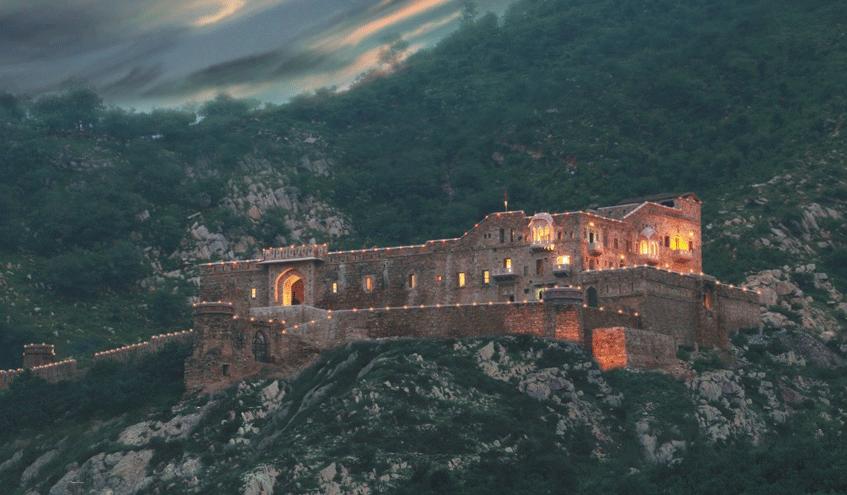
Neemrana
It was a tributary (chieftainship) of the former Alwar State. The region is sandy and bleak and is known as Raath. The place is said to be the home of chauhan Rajputs claiming descent from Prithvi Raj the last Hindu emperor. It is reputed to have been built by the Yaduvanshis, descendants of Lord Krishna, who converted to Islam in the mid-14th century to be called Khanzadas. It subsequently changed hands, being conquered by the Mughals and the Jats before reverting to the Rajputs in 1775 when the princely state of Alwar was founded. Lord Lake in 1803, as a punitive measure for the shelter and assistance given by the then chief of the Marathas, confiscated the villages of the estate and made them over to Alwar. However, about one third of the State was subsequently restored to the chief, who remained a tributary of Alwar State. This subordination of Neemrana to Alwar had been the subject of many disputes and controversies, which came to an end in 1861 when the chief refused to accept the supremacy of the Alwar ruler. The latter took this as an act of rebellion and took possession of the estate. The chief fled to Jaipur. However, the Viceroy in Council settled the dispute in 1868. Neemrana is known for its fort converted into a well known hotel which is also popular with Delhi’s weekend guests. Some well known industries have also settled here.
Neelkanth
A few miles west of Rajgarh town is the Neelkanth temple in the hills above Tehla village. Archaeologically it is one of the most interesting places. Once located on the plateau of the hills, this was a town adorned with temples and statues. Its old name is Rajorgarh.
Naldeshwar
This is situated amidst rocky hills at a distance of 24 Kms south of Alwar. The old Shiva temple has two natural bunds or ponds, which receive water from the surrounding hills. They are worth a visit especially when it becomes magical during rains.
The district has a dry climate with hot summer, a cold winter and a short monsoon season. During May the maximum temperature is around 41 °C and minimum is around 28 °C.
During January the maximum temperature is around 23 °C and minimum around 8 °C.
The normal annual rainfall in the district is 57.77 cms.
The average humidity: 70 per cent.


